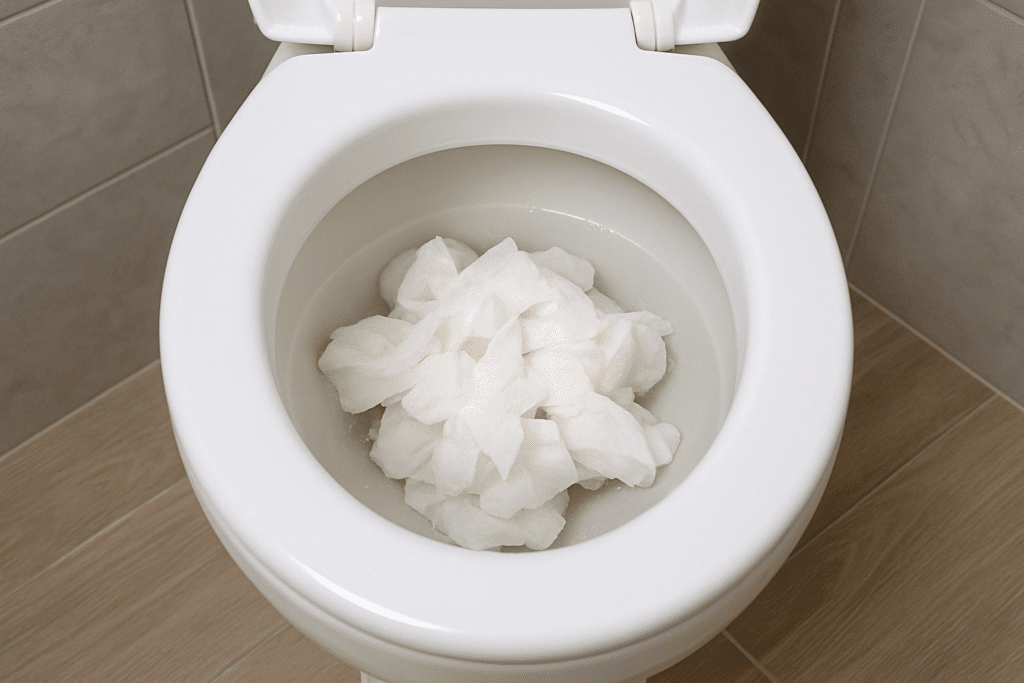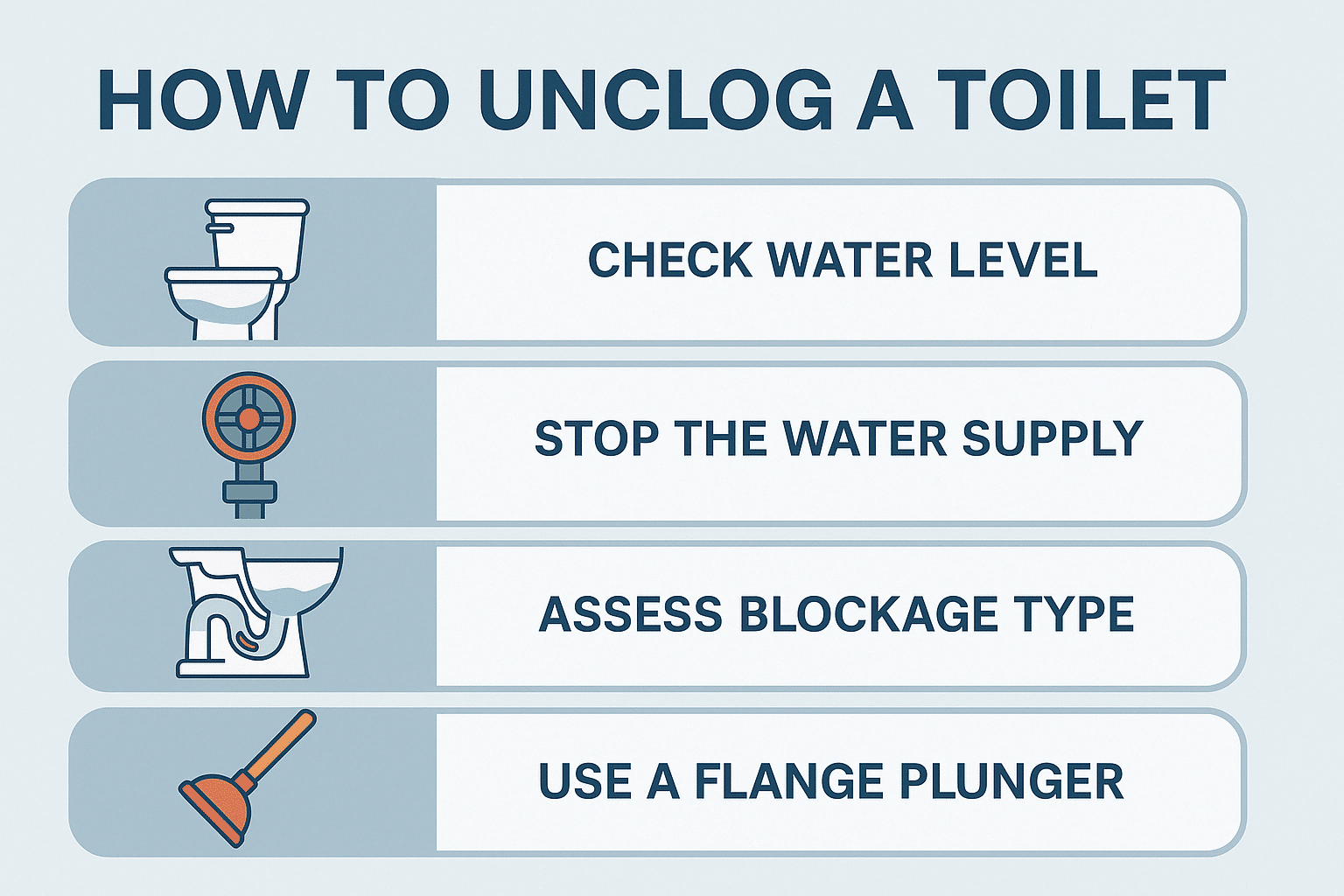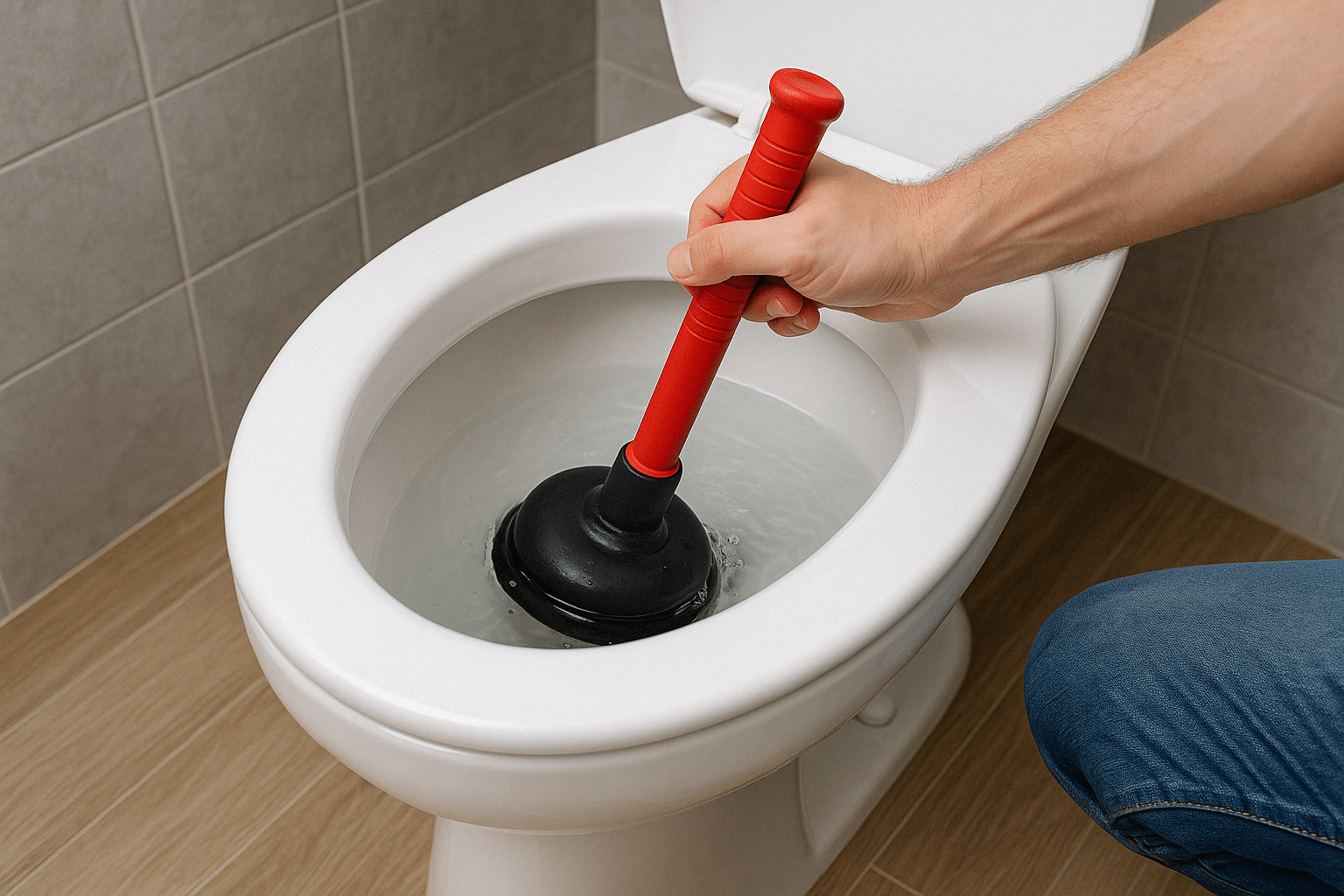
Blocked toilets are a common yet disruptive household issue. Whether caused by a build-up of paper or an unexpected foreign object, a clog can quickly escalate from a minor inconvenience to a messy problem. If you’re dealing with a blocked toilet Liverpool, understanding the causes and knowing the right steps to fix it can help avoid unnecessary stress — and expense.
This guide explains how to unclog a toilet safely and effectively. It also outlines when it’s time to seek professional help, and how to prevent future blockages from recurring.
Common Causes of Toilet Blockages
Build-up of toilet paper
Toilet paper is designed to dissolve in water, but excessive amounts can still cause trouble. When large wads are flushed all at once, they may clump together before breaking down, forming a physical barrier in the trap or pipe. Softer, thicker paper is often the main culprit, especially in older plumbing systems with narrower pipes.
Routine overuse becomes problematic over time. If flushing habits remain unchecked, even a functioning toilet may begin to slow down or back up regularly. Educating household members to flush smaller amounts of paper — especially in homes with children — can help maintain a clear path in the pipes.
Foreign objects
Toilets are built to handle human waste and paper only. Items like wet wipes, nappies, sanitary products, and even small toys often find their way into the bowl — and none of them belong there. These materials don’t break down easily and tend to lodge in tight bends or deeper sections of the pipework.
Once lodged, foreign objects create a partial or full obstruction, often resulting in slow drainage or a complete backup. These types of clogs can be difficult to remove without the right tools, and in many cases, may require professional intervention if the object gets stuck further down the line.
Low-flow toilet limitations
Modern low-flow toilets are designed to conserve water, which is environmentally beneficial, but not always ideal for clearing waste effectively. Early versions of these systems can struggle to generate enough pressure to push contents fully through the pipes, especially if they’re older or slightly misaligned.
Over time, these performance limitations can increase the chance of a clog forming, particularly if the toilet is paired with narrow or winding waste pipes. If a home consistently experiences poor flush performance, it may be worth considering an upgrade or modifying usage habits to improve flow.
Issues in the drain line
Sometimes, the toilet itself isn’t the problem. Tree roots, damaged pipes, or grease build-up in the main drain line can restrict the flow of waste water away from the property. When this happens, toilets, sinks, and other fixtures may all show signs of sluggish drainage or bubbling.
Diagnosing drain line issues can be tricky without professional equipment. If toilet blockages are recurring and seem to affect more than one area in the home, it’s likely the root cause lies beyond the bathroom. Ignoring the problem only increases the risk of overflows, so it’s best addressed quickly by a drainage specialist.
Initial Steps Before Attempting to Unclog a Toilet

Check the water level
Before reaching for any tools, it’s essential to assess the water level in the bowl. If the toilet is nearly overflowing, avoid flushing again. A second flush won’t move the blockage — it will only add more water to an already full bowl, increasing the risk of spillage onto the floor.
If the water level is low, this may suggest a partial blockage, allowing some flow past the obstruction. In either case, understanding the current water level can help decide whether a manual solution is appropriate, or whether it’s safer to begin with water shut-off and inspection.
Stop the water supply
To prevent any accidental overflows, locate the isolation valve behind or beside the toilet and turn it clockwise to stop the water flow. If there’s no valve present, remove the lid of the cistern and carefully lift the float to stop further refilling.
This step is especially important if the blockage seems severe. Cutting off the water gives more control over the situation and makes it easier to work on the toilet without risk of a mess. It also reduces pressure in the system, which is helpful if other methods are needed later.
Assess the blockage type
Not all clogs are equal. A soft blockage from too much paper can usually be dealt with using a plunger or warm water, whereas harder obstructions — like plastic items or hygiene products — may need a toilet auger. Knowing what’s likely stuck can save time and help avoid damaging the toilet during removal.
Try to remember if anything unusual was flushed recently. If small children are in the house, check if toys or objects are missing. In cases where the source isn’t clear and the toilet isn’t draining at all, professional assistance may be the safest route to avoid damage to pipes or fixtures.

How to Unclog a Toilet with Simple Tools
Using a plunger correctly
A good-quality plunger is often the first and most effective tool for dislodging a clog. Choose a flange plunger — one with an extended rubber flap — as it creates a better seal in the toilet bowl. Place the plunger directly over the hole, ensuring a tight seal, then use steady pressure to push and pull, forcing air and water through the pipe.
It usually takes 15–20 firm plunges to dislodge a typical clog. Avoid using too much force, as this can splash water or even damage porcelain. Once the water level starts to drop, it’s a sign that the blockage is shifting. When successful, finish with a single flush to clear the remaining waste.
How to use a toilet auger
If a plunger doesn’t work, a toilet auger (also called a plumbing snake) can be used to break up or hook onto stubborn blockages. Insert the curved end into the bowl and rotate the handle slowly to extend the coil into the pipe. If resistance is met, turn gently to either hook the obstruction or push through it.
Toilet augers are designed with a protective coating to avoid scratching porcelain, but care is still needed when inserting and withdrawing the coil. After breaking through the blockage, retract the auger slowly, and flush the toilet to ensure water flows freely again.
The hot water and washing-up liquid method
For softer blockages, especially those caused by paper build-up, a mix of hot water and washing-up liquid can often do the trick. Start by squirting a generous amount of washing-up liquid into the bowl. Let it sit for 5–10 minutes to coat and lubricate the pipe. Then pour in a bucket of hot (not boiling) water from waist height.
The combination of soap and water pressure can help break down the blockage and push it through the pipe. This method is especially effective when the toilet drains slowly but isn’t completely blocked. If the water level begins to drop, give it another flush to confirm the problem has cleared.
Baking soda and vinegar approach
As a natural alternative to chemical drain cleaners, baking soda and vinegar can help shift mild clogs while being gentle on pipes. Pour one cup of baking soda into the toilet bowl, followed by two cups of white vinegar. The mixture will fizz on contact — leave it for around 30 minutes before adding hot water to flush.
This method can break up grime and residue clinging to the pipe walls, making it useful for slow-draining toilets or minor build-ups. However, it’s not suitable for harder obstructions like sanitary products or toys, and may be less effective if the toilet is completely backed up.
What to Avoid When Unclogging a Toilet
Avoid chemical drain cleaners
While it might be tempting to reach for a chemical solution, most drain cleaners are not intended for use in toilets. They can cause damage to porcelain, corrode internal parts, and are often ineffective against solid blockages. The harsh ingredients can also be hazardous if they splash or release fumes.
Repeated use of these products can worsen problems by hardening certain materials, making them more difficult to remove. If used improperly, chemical cleaners can even create a dangerous situation when mixed with other substances like bleach or vinegar. Safer manual methods are always the better first choice.
Don’t flush repeatedly
Flushing multiple times in quick succession when the toilet is blocked won’t move the clog — it will only raise the water level. This increases the chance of overflowing and can make a simple problem far worse. Instead, observe how the toilet responds to the first flush and stop immediately if the water rises too high.
It’s easy to panic when water starts to back up, but patience and preparation are more effective than repeated attempts. Take a moment to shut off the water supply and assess the situation before trying any methods to clear the blockage.
Be cautious with wire hangers
Some online tips suggest straightening a wire coat hanger to poke through clogs. While this may work in rare cases, it’s generally not recommended. The sharp metal can scratch or chip the porcelain, leading to permanent cosmetic damage or weakened areas that may crack over time.
More importantly, wire hangers lack the flexibility needed to navigate toilet bends without risking a puncture in older pipes or damaging the internal trap. Safer tools like a proper auger are designed to protect the toilet while doing the job more effectively.
When to Call a Professional
Signs the blockage is deeper
If all standard methods fail and the water level remains high, it’s likely the blockage isn’t within reach of a plunger or auger. Deep clogs located further along the soil pipe or in the main drain require professional tools, such as high-pressure jetting or camera inspections, to locate and clear safely. This is often when people start to search online for signs my drain is blocked, especially if issues go beyond just the toilet.
Other signs of a deeper issue include bubbling from other drains when the toilet is flushed or slow draining in multiple areas of the home. These symptoms point to a system-wide problem rather than a localised one, which could indicate structural damage or external obstructions like tree roots.
Repeat blockages in short intervals
If the toilet clogs frequently despite cautious use, the underlying issue may be a damaged pipe or a partial blockage that isn’t fully clearing. Temporary fixes might provide short-term relief, but the problem will persist until the root cause is identified and resolved.
Frequent blockages may also indicate poor installation or misaligned pipework. Professional assessment can reveal these faults quickly using diagnostic tools. Addressing the problem early can prevent more serious issues such as leaks, overflows, or long-term water damage.
Water backing up elsewhere in the home
One of the clearest signs of a more serious drainage issue is water coming back up through other fixtures when the toilet is flushed. This includes gurgling sounds in sinks, water appearing in the bath or shower, or strange smells from floor drains.
These symptoms often point to a clog in the main soil pipe or a full system blockage. Left unchecked, it could cause widespread flooding or contamination. In such cases, emergency drainage support is essential to prevent property damage and restore safe function.
Preventing Future Toilet Clogs
Proper flushing habits
Toilets are only built to handle waste and toilet paper — nothing else. Reminding all members of the household to avoid flushing wipes, cotton buds, and hygiene products can significantly reduce the risk of blockages. Even products labelled “flushable” don’t always break down effectively in UK systems.
Limiting toilet paper usage and spreading out flushes when needed can help maintain flow. In households with multiple users or children, consider putting up a discreet reminder in the bathroom to guide proper use without causing embarrassment.
Regular inspections and maintenance
Homeowners often overlook the importance of routine plumbing checks. Scheduling a periodic inspection — especially in older properties — can help spot early signs of wear or partial blockages. Professionals can carry out drain camera surveys or water pressure tests to ensure everything is flowing correctly.
Proactive maintenance might include descaling, tree root control, or adjustments to low-flow systems that struggle with performance. Taking action early reduces the likelihood of a surprise backup and saves on repair costs later.
Tips for households with children
Young children are curious and often fascinated by toilets. Toys, tissue, and even food can find their way into the bowl during play. Installing a child-proof seat or having gentle conversations about what should and shouldn’t be flushed can prevent unintentional clogs.
It also helps to keep the bathroom stocked with a bin for wipes and hygiene products, clearly showing that the toilet isn’t a catch-all waste point. Some parents even perform regular checks after their child uses the toilet to catch any small issues before they become bigger ones.
Final Thoughts on How to Unclog a Toilet
Understanding how to unclog a toilet doesn’t require specialist training — but it does benefit from a calm, methodical approach. Most household blockages are caused by avoidable habits or minor build-ups, and can often be solved with basic tools and a little patience. Knowing when to stop and call in a professional is just as important as knowing what steps to take first.
Prevention is always easier than cure. A few changes in daily habits, paired with regular checks and timely action when problems arise, can keep toilets flowing properly year-round. For persistent issues or concerns about deeper drainage problems, professional support provides peace of mind and lasting results.
Recent Posts
- Guide to Clearing Blocked Drains: Causes & Solutions November 24, 2025
- Drainage Jetting Explained: How It Clears Blocked Drains October 25, 2025
- Clean Out Gutters Like a Pro: Step-by-Step Guide October 25, 2025
- CCTV Drain Inspection for Detecting Tree Root Blockages August 14, 2025
- How To Clear Roots From Drain Pipes July 11, 2025
Categories
- Drain Repairs (40)
- Drain Surveys (24)
- Drain Unblocking (60)
- Rodent Drain Problems (1)
- Uncategorized (2)
- Vacuum Tankers (2)
